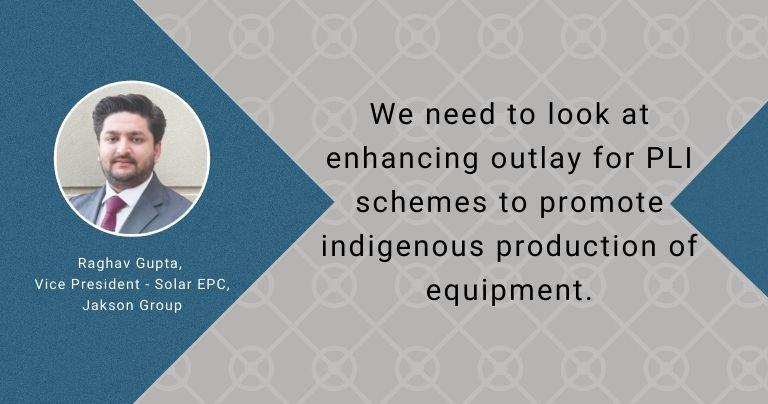It is critical to create demand-supply equilibrium and sustainable pricing for Solar PV
By EPR Magazine Editorial January 5, 2022 2:04 pm IST
By EPR Magazine Editorial January 5, 2022 2:04 pm IST

Raghav Gupta, Vice President – Solar EPC, Jakson Group, in an interview with EPR Magazine.
Developments and demand drivers for Solar EPC in India
Grid connected solar power in India has seen a consistent year-on-year increase of 30 percent on average since 2018. Solar capacities in India have multiplied 21 times from being 2.3 GW in 2013, to 48.5 GW in Nov 2021, which dwarfs all other installed capacities of energy. However, the rate of installation still needs to evolve by almost 10 times to reach the goal of 450 GW until 2030 set by PM Modi during COP26 at Glasgow, Scotland.
Major drivers fuelling this growth
India has a solar energy potential of 5000 Trillion units per year with 4-7 units/ sq.m /day. Sharp decline in capital costs by 52 percent between 2010 and 2020. LCOE of solar plants lowered dramatically to $37 USD/MWh versus coal-fired plants at $66USD/ MWh in 2020. Also, FDI up to 100 percent allowed under the automatic route has attracted USD7.5 Billion between April 2000 and Dec 2018.
A profound awareness of global warming has prompted urgency on reduction of carbon emissions and adopting renewable as a primary source of energy. India being one of the top 5 producers of carbon has pledged to attain carbon neutrality by 2070. Furthermore, India has raised its NDC commitment to achieve 50 percent energy share from non-fossil fuel-based sources by 2030.
Promoting solar energy and increasing manufacturing capacityPost announcement of BCD on cells (25 percent) and modules (40 percent) by MNRE, a monumental avenue for module/cell manufacturers have created to promote ‘Atmanirbhar Bharat’ movement. Further stimulus announced by IREDA budgets an outlay of ₹4500 Crore for 10 GW (4 stage, Polysilicon to Module) in a PLI scheme which has been awarded to Jindal Solar, Shirdi Sai Electricals and Reliance.
Required interventions for policies, regulations and finances
In current environment of cost volatility, MNRE can incorporate price variation for commodity and PV modules under utility PPA with developers. Developers should be allowed to pass on benefit to the contractors, who in turn can enjoy some space while forward pricing a contract. Further, we need to look at enhancing outlay for PLI schemes to promote indigenous production of equipment. Consequentially enabling Indian solar market to bring the supply-demand gap to equilibrium and create sustainable price point for PV modules.
Incentivise R&D around development of technology for higher efficiency and power density equipment, which would allow investors to optimise balance of plant (BoP) costs and position India as a global preference for equipment import.
The way forward products and business projections
Jakson group is uniquely positioned to cater the entire value chain of solar energy market. Starting from PV module/MMS manufacturing to turnkey EPC services and Solar IPP plants, Jakson has a multi-tiered presence across the solar energy industry. Presently, Jakson’s manufacturing capacity stands at 500MW of PV modules annually coupled with a proven track-record of providing 1.5 GW of turnkey EPC services for private clients and PSUs. Our investment portfolio includes 200MW of solar IPP as well. Jakson’s short-term plans include expanding footprint to international geographies with a target of providing 2 GW of EPC globally along with 1 GW of annual production of PV modules by 2022.
We use cookies to personalize your experience. By continuing to visit this website you agree to our Terms & Conditions, Privacy Policy and Cookie Policy.